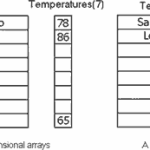A standard structure for storing data in any programming language is the array. Whereas individual variables can hold single entities, such as one number, one date, or one string, arrays can hold sets of data of the same type (a set of numbers, a … [Read more...] about Arrays in Visual Basic
Using Variables and Data Types
Initializing Arrays and Array Limits
Just as you can initialize variables in the same line in which you declare them, you can initialize arrays, too, with the following constructor (an array initializer, as it's called): Here's an example that initializes an array of … [Read more...] about Initializing Arrays and Array Limits
Multidimensional Arrays
One-dimensional arrays, such as those presented so far, are good for storing long sequences of one-dimensional data (such as names or temperatures). But how would you store a list of cities and their average temperatures in an array? Or names and … [Read more...] about Multidimensional Arrays
Dynamic Arrays
Sometimes you may not know how large to make an array. Instead of making it large enough to hold the (anticipated) maximum number of data (which means that, on the average, part of the array may be empty), you can declare a dynamic array. The size of … [Read more...] about Dynamic Arrays



